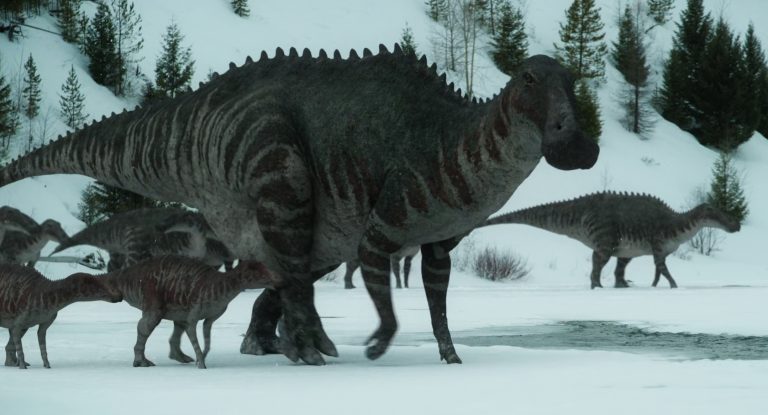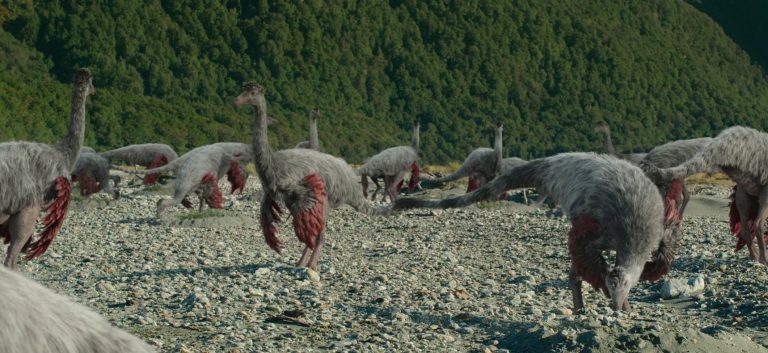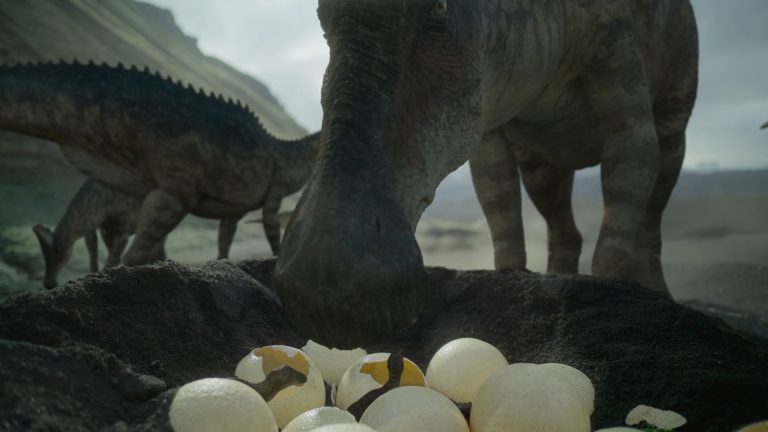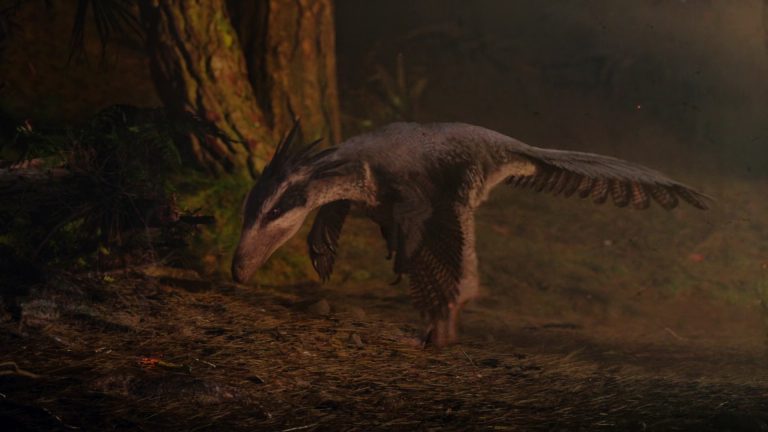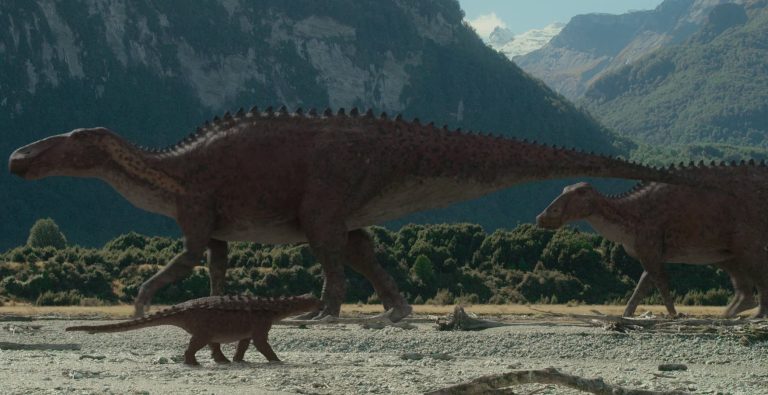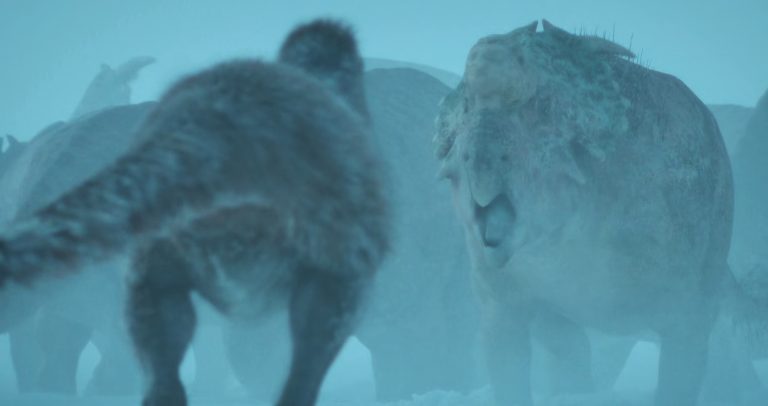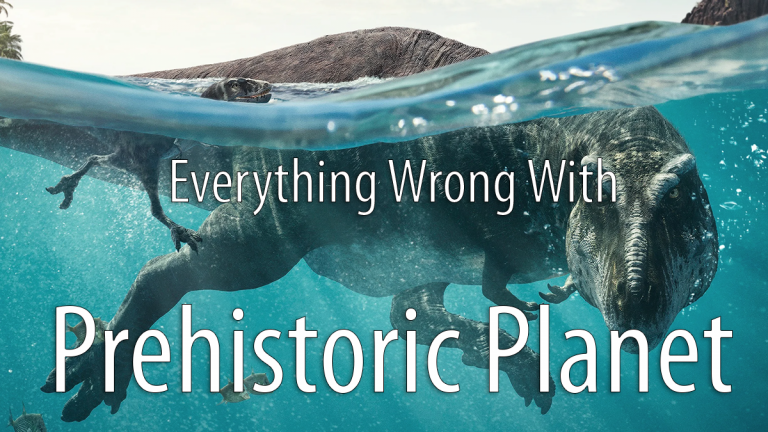
For a primer on this blog series and an FAQ see here.
| Other Episodes |
||||
| Coasts | Deserts | Freshwater | Ice Worlds | Forests |
| Islands | Badlands | Swamps | Oceans | North America |

This episode features advisement by the following paleontology consultants:
- Victoria Arbour
- Steve Brusatte
- Alexander Farnsworth
- Tony Fiorillo
- Scott Hartman
- John Hutchinson
- Robert Spicer
- Paul Valdes
- Mark Witton
- Darren Naish
This episode is easily the most fanciful in its interpretations. It pushes a modern-day paleontology myth about a highly temperate Mesozoic that is worthy of a blog post all of its own. I’m keeping things tight here for the sake of the sin theme, but I’ll likely revisit this topic again in the future.
Direct misinformation
The title of this episode is Ice Worlds. So, right off the bat we are pushing a narrative of a cold and icy part of the Mesozoic. Such an interpretation flies in the face of most geological and paleobotanical evidence from the Mesozoic. This was a time period of high heat and rather limited seasonal changes across the planet. Yes, there were seasons and yes there were some “chilly” areas of the world, but those chilly areas rarely dropped below freezing and even then probably didn’t do so for more than a week or two out of the year. The whole concept of there even being seasonal ice is controversial for any part of the Mesozoic.
Scene 1: Arctic Circle, North America
Baseless speculation
Harsh temperatures of the paleo poles
Attenborough starts the show off by discussing the harsh temperatures experienced at the poles during this time in the Maastrichtian. This sets the conceptual framework for the rest of the episode where viewers are expecting temperatures on par with the modern-day Arctic. To the show’s credit, during the B-roll of the Arctic, Attenborough does mention that the poles at this time were “relatively warm”. It would have been nice if the show had put some actual numbers to this. Our current estimate for the temperature at the paleo poles during the Late Cretaceous indicates a mean annual temperature of 6–7°C (Herman et al. 2016). The modern-day Arctic circle has a mean annual temperature of -9°C – 0°C and is characterized by extensive permafrost. There are no data to support permafrost during any part of the Mesozoic. So, polar temperatures would have been harsh by Mesozoic standards, but nowhere near the kind of harsh that we see in modern-day environments. We are talking about polar extremes that were about as bad as modern-day Seattle Washington.
Dinosaurs in snow
We are shown dinosaurs making tracks in significant piles of snow along with B-Roll of the modern-day, snow-capped Arctic. This is unlikely at best and directly misleading at worst. Mesozoic snow would have been rare globally and even then was probably limited to high altitudes (where we unfortunately do not have any fossils). I would expect a dusting here and there rather than any significant accumulation. We will return to this theme later.
The need for plumage…or not
Attenborough mentions that the feathers on the star of this scene, an unnamed dromaeosaur (more on this below) are necessary for maintaining its body temperature in this “frigid” environment. As discussed earlier, these environments were chilly at worst. Hermann et al. (2016) estimated a cold month mean temperature of -2°C (range: -5.9°C – +1.9°C) and the coldest winters dipping down to -10°C for a short period of time. All of this is cold for the Mesozoic. For reference, Western Yellow-Bellied Racers (Coluber constrictor mormon) live in South-Central British Columbia, where the average cold winter month is -2°C.
All this is actually besides the point, because right after Attenborough tells us how necessary feathers are for maintaining body temperature we are introduced to a herd of scaly hadrosaurs happily roaming this “frigid” environment. We are also shown a beetle getting along just fine in this alleged cold. Apparently plumage only matters if you are a theropod. This disjointed narrative will appear again later in this episode.
Nomadic Edmontosaurus
The other star of this scene is Edmontosaurus sp. (formerly Ugrunaaluk). Attenborough informs us that these animals are nomads that must constantly migrate in search of new vegetation. The way that it is portrayed in the show is suggestive of the old “happy wanderers” hypothesis for Arctic dinosaurs (Hotton 1980) in which the animals would follow the sun line around the Arctic, avoiding the dead of night. Feasibility tests (Bell and Snively 2008), presence of juveniles and hatchlings (Druckenmiller et al. 2021), along with dental microwear data on diet (Fiorillo 2011) all indicate that Edmontosaurus was a year-round resident that did little migrating.
Notably, Naish does discuss this in the Twitter Megathread and states that their Edmontosaurus were not meant to be migratory. So, maybe this was a mixup in editing.
Return of group hunting dromaeosaurs
This is pretty par for the course with PP, but once again we are shown these dromaeosaurs working as a team to scare the Edmontosaurus herd and separate a juvenile for easy pickings. Naish insists in the megathread that we have evidence to support such behaviours in dromaeosaurs. I sure would love to know where that evidence is. At the moment, it seems to lean heavily on anecdotal evidence of “group hunting” in various sauropsids (see the Prehistoric Planet Uncovered segment for this episode). This scene where the herd is scared into crossing a raging river is reminiscent of Centrosaurus apertus paleo-art from the ’90s.
Weird artistic choice
Eye shape
One of the stars of this scene is an unnamed dromaeosaur. It’s neither given a species nor genus name, but according to the Twitter Megathread, it was based on Dromaeosaurus albertensis. I find it interesting given all the hemming and hawing over having to place Velociraptor mongoliensis outside of its actual time period that now its suddenly okay to just keep an unnamed dromaeosaur as an unnamed dromaeosaur. Anyway, that’s not the sin here. In this case it’s the fact that we have a dromaeosaur running around in the darkness of a night that lasted several months, yet showing contracted, circular pupils. Given the light regime the least one should expect here would be very dilated pupils. Given these dromaeosaurs vertical pupils would have also made sense here (though, they would be so dilated in this scene that we couldn’t tell). However, no dinosaur in PP has vertical pupils. Most species show the same circular pupils. I suspect that this was an area of anatomy that was largely ignored except when to show the nictitating membrane or mammalian-like (i.e., Disney) emotions.
Torrential ice flow
When the herd of Edmontosaurus are crossing the river, Attenborough tells us that the herd must cross this “fast flowing river”. Yet, when we look at the river we see large sheets of ice covering most of the surface. This tells us that the water is somewhere around 0°C. If these animals are crossing this chilly river then their first worry would be hypothermia, not being swept away. This is all the more pertinent for the smaller juveniles, which would be more susceptible to hypothermia.
Mass death for a simple lunch
This scene culminates in the mass death of several Edmontosaurus as they drown in the river. All of this is catalyzed by the presence of the three dromaeosaurs egging the animals on. The way this scene played out I believe was meant to showcase planning on the part of the dromaeosaurs, but it mostly comes off as a chaotic mess as a duo of easily stomped on theropods somehow panic a herd of hadrosaurs well over an order of magnitude in size larger than them. If this scene showcases anything, it shows how panicky and dumb Edmontosaurus was, which seems antithetical to the goal of the Prehistoric Planet series.
Scene 2: Arctic, down river
Weird artistic choices
The worst place to build a nest
The star of this scene is a group of Ornithomimus edmonticus. The group are building their nests on little islands in a flood plain. This is just a terrible place to build a nest as these are areas where future flooding obviously occurs. It just takes one bad rainstorm to wipe out an entire generation.
Useless arms
O. edmonticus along with all other ornithomimosaurs, are characterized by long arms with slender, grasping hands. These arms could easily grab nesting material and move eggs around. Yet, throughout this scene we are shown the arms as these useless vestiges that are kept to the side throughout the entire scene. It plays into another modern paleo myth that theropods didn’t use their arms. I have much more to say on this in a future post, but for now I’ll just leave it as a poor inference based on range of motion studies that do not take into account the substantial amount of cartilage around the bones and joints of sauropsids.
Baseless speculation
Dinosaur cacophany
As with other scenes in PP, as well as most other dinosaur prehistorical fiction masquerading as a documentaries, the dinosaurs in this scene are constantly making noises. This seems like a great way to invite predators to an easy meal. Sound-wise, we have no idea what O. edmonticus sounded like, but it was doubtful that it was as chatty as shown in this scene.
Nest building, nest stealing
This scene focuses on individuals in this group trying to build an enticing nest for females to lay their eggs (more on this below). In the process, we witness a lot of nest part stealing taking place. In reality, we have no nest material for ornithomimids, so we have nothing to go on here. Did they build nests to entice females, or did females go off and lay in a hole they dug instead? These are unknowns at this time.
Mostly speculation
Plumage type and patterning
All the O. edmonticus in this scene are shown with fully protofeathered bodies, complete with pennaceous feathers on their forelimbs. This is based on some surprising fossils described by Zelenitsky et al. (2012). Importantly, the authors found primary evidence of stage 1 protofeathers (i.e., simple, hollow filaments). The authors then described black marks on the forearm bones as evidence for pennaceous feathers, comparing their results to the potential quill knobs in a specimen of Velociraptor mongoliensis. (Turner et al. 2007). However, in this case, the “knobs” are not knobs at all but carbonaceous deposits that somewhat align with the location of the calami in pennaceous feathers. It’s a weak association found only in a single individual and it requires that all the muscles in the forelimbs degrade away before the feathers disappeared. All of this is unlikely for a critter preserved in a river (sandstone). It’s more likely that these are remnants of muscle tissue that happen to align with potential feathers.
Regardless, the popularity of the pennaceous ornithomimid has been present since 2012, leading to what we see in Prehistoric Planet. Even the colour scheme aligns with original artist interpretations of plumage in O. edmonticus. In reality, we only have evidence for stage 1 protofeathers in ornithomimids.
Also, why are their legs naked? This is taking the “ostrich mimic” moniker a bit too literal.
No girls allowed
All of the O. edmonticus in this scene are males. The narrative here being that males have gathered together to form nests that will attract females here to lay their eggs…and then leave them. This interpretation of dinosaur parenting comes from statistical work by Varricchio et al. 2008, in which the authors correlated clutch volume to nesting habits of three different bird models and one crocodylian model. Based on their regression statistics, maniraptorans were found to align best with a paternal care model for parental care. Paternal only care is rare in birds, it is most commonly found in ratites, which happen to also be the most basally branching extant bird group. Males take care of eggs from several females. So, there is some data to support this. I will say that looking at the regression data provided by Varricchio et al., I don’t think one can really determine if maniraptorans fit better with avian paternal care or crocodylian maternal care based on clutch size. The dinosaur data graphs pretty well within the spread of data for both methods. Further, the crocodylian regression data poorly explains the spread of its extant group anyway (r2 of 0.65, see the supplemental data), which may increase the likelihood of maniraptoran data fitting here. There is also a histology angle to this but it hasn’t held up that great over time (female crocodylians store calcium differently than female birds). So, while this is an idea for ornithomimid reproduction, it could easily have gone the other way too.
Oh, and the bowerbird style of mate selection here is completely made up.
Scene 3: Arctic Circle – Russia
Weird artistic choice
What’s in a name?
Olorotitan arharensis is the star in this scene and the only dinosaur in the entire PP series to have its genus name defined (Titanic swan). It seems weird to single out this dinosaur and not do this for all the other dinosaurs. I imagine viewers would be very interested to hear the meanings behind all dinosaur names.
Baseless speculation
Volcanic nesting
We are shown a herd of O. arharensis as they build their nests on volcanically warmed soil. While we are pretty certain that hadrosaurs built nests up in the Arctic circle (we have fossils of juveniles), we don’t have any evidence that they used volcanically warmed soil to warm their eggs. In the Megathread, Naish states that we do have evidence that some dinosaurs took advantage of geothermal heat to warm their nests. This comes from a 2012 paper that describes sauropod nests from geothermally active areas of Early Cretaceous Argentina (Fioreli et al. 2012). This was a surprising discovery at the time, but one that does make sense in light of how some extant animals search out similar nesting sites today (namely, Galapagos tortoises). That said, we don’t know if any hadrosaurs did this, and the area that this scene describes (Okhotsk-Chukotka Volcanic Belt) has yet to produce any nests. I found this to be a strange choice for hadrosaur nesting given how much we actually do know about hadrosaur nests and incubation times.
Fast incubation times
Our volcanic nesting O. arharensis are said to hatch only“a few weeks after the arrival of the herd”. This argument is based on the species laying on geothermally active soil, but it’s not explicitly mentioned in the show. Adding insult to injury here, Naish mentions in the Megathread:
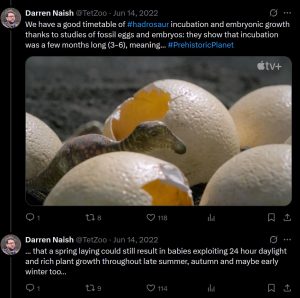
This information comes from a study by Erickson et al. (2017) in which they looked at embryonic tooth development and counted the daily increments of growth (von Ebner lines) to come up with a minimum time it took for eggs to hatch. Their results found that the small ceratopsian, Protoceratops andrewsi took a minimum of 2.8 months to hatch, whereas the hadrosaur, Hypacrosaurus stebingeri took a minimum of 5.8 months. This is a far cry from the “few weeks” that we are shown here, and it raises a lot of issues of how Arctic dinosaurs were able to survive in these chillier conditions. If hatchling hadrosaurs took ~6 months to hatch, and they were laid at the start of spring, then the animals would already be experiencing prolonged twilight by the time they came out of the eggs, and complete darkness shortly thereafter. These all lead to interesting questions of dinosaur survival in the Arctic, but none that are even partially addressed by the show. Instead, we are shown an outlier example.
Parental feeding
O. arharensis mother is shown feeding her young, suggesting altriciality in this species. Okay, so will get the obvious bit out of the way first. We don’t have any hatchling, or nest data for O. arharensis. It’s known from a single, well-preserved fossil from the Kundur, Amur Region in Eastern Russia (Godefroit et al. 2003). So, this behaviour is based on inferences from other hadrosaurs. Namely, it’s based on Maiasaura peeblesorum. Mass nest sites with trampled remains were used as evidence that extended parental care was present in M. peeblesorum at least, if not all hadrosaurs (as showcased in Prehistoric Planet). Osteohistology of hatchling long bones found a lack of a fibrocartilaginous cap, further suggesting that hatchlings were altricial and incapable of leaving the nest (Horner and Weishampel 1988). However, follow-up work on this study has cast doubts on the altricial angle, as cartilage is more likely to disappear during fossilization, whereas the pelvic girdle of all embryonic dinosaur fossils indicates substantial ossification prior to hatching, thus supporting a more precocial development (Geist and Jones 1996). Worth noting is that Horner does not agree with this interpretation and did fire back (Horner et al. 2001), so there is some wiggle room here. Personally, I think that prior to Holliday et al. 2010 (and a over-cited abstract from 2001), paleontologists really didn’t appreciate just how different joint articulations are in dinosaurs when you account for articular cartilage. So, I tend to lean more on the precocial side of this argument, especially given that altriciality is a highly derived trait that doesn’t appear until well into Aves. So, a light sin here based on personal preference.
Cuddly babies
This sin, on the other hand, gets no qualifiers. We are shown the O. arharensis babies cuddling up to mom and acting cute. This is a very mammalian-like trait that is further exacerbated by the likes of companies like Disney. We have no reason to show a dinosaur acting like a mammal here.
Growing like weeds
Attenborough tells us that O. arharensis grows to half its adult size in its first year. One the one hand, we once again only have a single individual to go off of for this species, but even then, with an estimated adult mass around 2.6–3.4 tonnes (Godefroit et al. 2012), reaching half adult size means popping on around 1,300–1,700 kg/yr. Even if we are generous and assume a hatchling mass of 1 kg, that’s still a substantially faster growth rate than the estimated 593–859 kg/yr for the equivalent sized M. peeblesorum, the hadrosaur that we have the best life history information for (Woodward et al. 2015). All that for a dinosaur living in an area of the world that is less productive than lower latitudes.
Thin skinned
As the scene plays on we see swarms of mosquitoes bothering the O. arharensis herd. Attenborough informs us that these hadrosaurs have “remarkably thin skin”. This is a weird statement to make because we actually have enough hadrosaur skin impressions to measure skin thickness. Studies of hadrosaur skin impressions indicate that hadrosaur skin was between 2.5–3.5 mm thick (Manning et al. 2009), which is on par with crocodylian skin thickness (2.83 +/- 0.41 mm; Chala et al. 2020). Crocs do get bothered by mosquitoes, but its all around their eyes, nose, ears, and the few other places where mucosa reaches the surface. Had Attenborough said that the mosquitoes focused on these regions, this section would have been fine, but nope. Apparently all the skin was thin.
Head bobbing
As the O. arharensis herd move round we can see them bobbing their heads a bit like birds. There is no reason to do this. Hadrosaur eyes were not so big that their extraocular muscles couldn’t adjust to head movements without moving the entire head as in birds. I don’t know if this was meant to be a subtle nod to birds or if it was based on wildebeest. Either way, I don’t see a justification for this movement.
Narrow gauge forelimbs
Our hadrosaur herd are quite dainty footed with their walking. However, hadrosaur trackways and arm biomechanics suggest a more splayed (semi-erect) stance for the forelimbs (Senter 2012).
Mostly speculation
Clutch size
Attenborough tells us that O. arharensis laid about 20 eggs per clutch. As we have no nest data for this species this part is made up. However, it is likely based on the substantial nesting data that we have available for M. peeblesorum, which is then distributed to other hadrosaurs. So…within reason.
The weak are left behind
As the O. arharensis herd head to higher ground to get away from the mosquito swarm, Attenborough informs us that if the young are unable to make it up the steep hill side they will be left behind. This is a fairly realistic take on how sauropsids care for their young. Strong parental instincts up to a point. After that, the young need to figure shit out for themselves. Of course, we have no behavioural data to back this up for this species, or any dinosaur, but again, within some reason.
Reasonable inference…but still speculation
Colder temperatures this far north
Attenborough mentions how temperatures get colder and the conditions worsen the further north we go. This is true, but its important to mention the blunting effect of the much more equable climate regime during the entire Mesozoic (and into the early Cenozoic). Yes, temperature dropped as one moves up towards the poles, but it would be a shallow drop compared to the much steeper temperature gradients experienced today. Few moments in this episode every really tackle the vast difference in polar climates of the Mesozoic vs. today.
Trumpeters
Attenborough informs us that the elaborate crests of O. arharensis amplified the sounds coming from the animals. This is based on Parasaurolophus work and has been inferred for other hadrosaurs (e.g., Weishampel 1997). I would argue that the sound may have been directly coming from the crest, as these dinosaurs may not have had vocal folds (Senter 2008). However, either primary or secondary sound production are valid hypotheses here. What doesn’t work is having the animals open their mouths to make sound. If the nasal crest is going to amplify sound then the sound waves need to have access to it. Opening the mouth defeats this purpose. I don’t doubt it was done to make things seem more “realistic” for the viewers, but the truth of the matter is that most sauropsid sounds are done with closed mouths, not open ones.
Superfoods
Attenborough informs the audience that the horsetails (Equisetum) eaten by the young O. arharensis are more nutrient dense than extant grasses. This is based on studies of plant digestibility originally by Hummel et al. (2008) and later expanded on by Gee (2011). Their results do show that horsetails are among a group of Mesozoic plants that could be broken down enough to release a large amount of nutrients to the animal, a kicker here is that it requires some substantial fermentation to gain access to those nutrients. Adult O. aharensis could do this as they would have had guts capacious enough to ferment the plants. Hatchlings and juveniles would have been more limited in their access. So, they may have had to rely more on supplemental protein via insects and possibly even the poop of adults.
Scene 4: Arctic North America, forest fire
Baseless speculation
Mesozoic tinder box
Attenborough tells us how the warm air of the summer produces frequent lightning storms and that the fast growing vegetation is “baked tinder dry”, leading to massive forest fires. This statement appears to go against Mesozoic climate models for The Arctic which all indicate the presence of a persistent cloud cap over The Arctic that would have led to a near constant drizzle or fog cover (see discussion in Fiorillo 2018). It’s doubtful that things were ever baked “tinder dry” at either Mesozoic pole. In the Twitter Megathread, Naish mentions the abundant charcoal deposits from different areas of the Cretaceous that are indicative of large and frequent wildfires. While true, nearly all of these charcoal deposits are from lower latitudes that were well away from these polar cloud forests. The singular exception to this appears to be a charcoal deposit from James Ross Island, Antarctica (de Lima et al. 2021). However, as the authors noted in the paper, those wildfires were almost certainly caused by the extensive volcanic activity present in Antarctica at the time. So, once again, no tinder box conditions.
Unnamed troodontid with super vision
The star of this scene is an unnamed troodontid (so, again we are fine with not naming specific species). We are told that this species is well adapted for exploring this fiery hellscape as its vision lets it see through smoke. Um, what? How does that work, exactly? Are they implying that troodontids had thermal vision akin to The Predator? We barely have enough primary data to give us details on eye size and potential acuity, much less being able to see through smoke.
Dinosaur arsonist
The major part of this scene is our unnamed troodontid taking burning branches and spreading the fire to different areas of the forest to flush out prey. On the outset this seems like an insane level of anthropomorphism. However, as Naish discusses in the Megathread, it is based on extant animals. This behaviour is based on alleged observed behaviours of a handful of Australian birds at forest fires and (maybe) campfires (Bonta et al. 2017). Black Kites (Milvus migrans), Whistling Kites (Haliastur sphenurus), and Brown Falcons (Falco berigora) have all been observed carrying burning sticks from fires and moving them to different areas of the forest to spread the fire. The kicker here, though, is that the authors of this study relied solely on “credible witnesses” with first or secondhand accounts of what was happening. There are no observational studies (i.e., no recordings) of these birds doing this, and even one of the accounts suspects that any fire spreading was accidental (Braithwaite and Estbergs 1987).
Regardless, this is a unique behaviour limited to a handful of specialized birds. There is no benefit to taking this rare behaviour and copying it over to this arctic troodontid. Especially given that the birds are flying these sticks from place to place whereas the troodontid has to run it from spot to spot. The latter is far less efficient and unlikely to increase fire spread any faster than natural. The birds are also using their feet to briefly carry these burning sticks whereas our poor troodontid suffers from broken arm syndrome and is forced to carry this burning stick in its mouth, risking singeing its face every time. This is one of the more fanciful dinosaur behaviour interpretations that PP proposes.
Smarty pants
Attenborough lets us know that this unnamed troodontid is the most intelligent, adaptable, and successful predator of The Arctic. This is partially based on the large brains relative to body size for troodontidae, but nothing specific for this unnamed species. As for adaptability and success, we know nothing about any of this.
Missed opportunity
Sickle claw
A neat thing about troodontids is that they share the same raised sickle claw of dromaeosaurids, albeit much smaller in size. While it’s possible and maybe even likely that this was more of a vestigial structure in troodontids, it still would have been nice to see this claw put to use by something in the show.
Scene 5: Antarctic Winter
Baseless speculation
Glacial Antarctica
We are given a B-roll shot of Antarctica in the Late Cretaceous. As the camera pans, we see a large antarctic glacier and Attenborough tells us that:
“Ice clings to the highest mountains even in the summer months.”
All evidence for Mesozoic glaciation is controversial and mostly rely on dropstones (large stones that would be carried by ice rafts and later fall in place after the ice melted). Dropstones can be distributed in many different ways aside from glaciers (see Bennett et al. 1996, and the comment by Donovan and Pickerill 1997). The only other real evidence for glaciation comes from the need to soak up extra oceanic water, leading to recession of waterways (the draining of the Western Interior Seaway). This is more of a “necessary assumption” than anything based on real data. Continental positions are going to play a large part here too, and the raising of The Rocky Mountains (starting ~80 mya) will certainly push ocean water away from the continent. We’ll return to this again in the last scene.
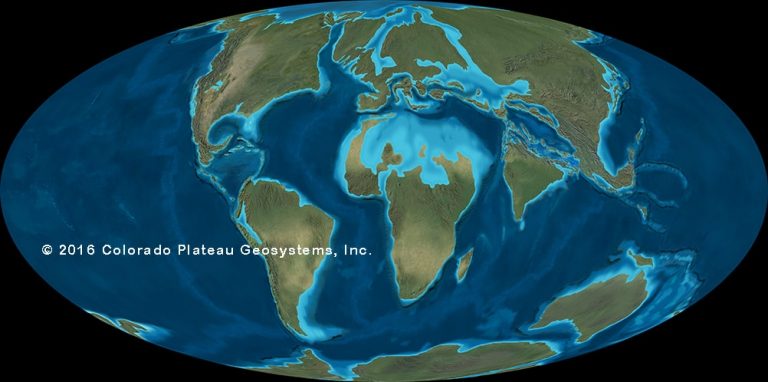
Lifestyles of the short and the armoured
The star of this scene is a group of Antarctopelta oliveroi. Attenborough informs us that this species is a good digger and that this small group of brothers will huddle together for warmth during the winter months. We have very little data on A. oliveroi and none of those data indicate that they were good at digging. They may have been. Several tortoises are phenomenal diggers despite not outwardly appearing built for that, so it’s certainly reasonable that several dinosaur species were capable of digging. However, without any direct studies this still falls under the realm of speculation.
As for huddling together for warmth, the concept is sound. We see this in several species across the thermophysiological spectrum (e.g., marine iguanas and emperor penguins). The kicker here is whether or not A. oliveroi was all that social. We only have a single, fragmentary skeleton to go off of (Salgado and Gasparini 2006). According to the megathread, this was inspired by fossils of Pinacosaurus grangeri juveniles that have been found together (e.g., Burns et al. 2011; Currie et al. 2011). So, we have more cut and paste of species behaviour going on here.
More migrating hadrosaurs
We get a brief visit from an unnamed hadrosaur and Attenborough informs the audience that this species will migrate to warmer climates as the temperature drops. We have no data to support this migration model for southern species (which are more poorly known overall than northern species). There is currently only one report of an Antarctic hadrosaur (Case et al. 2000). It’s based on an isolated tooth (there is also talk of an isolated femur from Bell and Snively 2008). So, there’s not really anything to go on here. I suspect that the migration angle is pushed for here specifically to explain why there is not much hadrosaur material from Antarctica. Regardless, it still speaks against the more provincial pattern we see in dinosaurs.
Freezing polar winter
Attenborough tells the audience that species that can’t migrate must endure the freezing polar winter. This is as wrong here as it is for The Arctic. It was chilly in the winter. It was rarely freezing.
Glowworm caves
Our lone A. oliveroi is seen making its way into a glowworm cave where it will stay for the rest of the winter. Glowworm caves are only found in New Zealand today. New Zealand really wasn’t around in the Mesozoic, so glowworm caves would be pretty unlikely. This scene is great for the imagery, but it’s very unlikely that this would have occurred in Antarctica. Any old cave would have done here. They didn’t need to make it so extra.
Also, as an aside, having been in a glowworm cave I’ll say that they really boosted the light output of these insects. Real glowworm caves are amazing, but much darker.
Mostly speculation
Year-round snow
This calls back to earlier when Attenborough mentions how snow is found on the peaks of the highest mountains throughout the year. This may be true, but we have no way of knowing as that is an area that is off limits to fossil preservation.
Hibernating A. oliveroi
The trio of A. oliveroi make there way to a smallish burrow where we are told they will spend most of the winter sleeping. This program dances around the idea of dinosaurs hibernating, but that’s essentially what is going on in this scene. I think that this is a reasonable assumption for most small to mid-sized polar dinosaurs. However, to date we have no evidence to say if this happened. It’s hard to nail down osteological signs of hibernation. The closest we get are Lines of Arrested Growth (LAGs) in the bones, but these just tell us that the bone has stopped growing, not why the bone stopped growing.
Reasonable inference…but still speculation
Cheeky eaters
A. oliveroi are shown eating moss from downed trees, showcasing their rather extensive cheeks. The exact shape of this region of the skull in life is hard to determine for dinosaurs, but the lack of any real muscle movement in this area seems to suggest that the cheeks are more like extensive fleshy coverings over the muscle insertions, as described by Nabavizadeh (2020). This feels like an okay compromise.
Scene 6: Arctic Blizzard
Baseless speculation
Polar climate interpretation
Time to get the core problem of this episode. Attenborough introduces this section by discussing the falling snow and how The Arctic freeze turns this place into “a spectacular winter wonderland”. This is by far the most controversial scene in the entire series. Not only are the showrunners arguing for freezing temperatures in The Arctic, despite most paleo data indicating its rarity, but they are now incorporating substantial snowfall into the mix. Where the hell are they getting this from?
Well, according to the Twitter Megathread, the PP team incorporated data from fellow consultants and paleoclimate researchers, Alexander Farnsworth and Robert Spicer. Farnsworth gives a brief and all too simplistic description of what their team did for the show in this Conversation piece. In this piece, Farnsworth discusses how the BBC needed data on specific weather patterns so they would know where to film analogous locations for the show. To do this, Farnsworth’s team used their climate modeling software to simulate daily weather patterns. Yes, I emphasized that for effect because as anyone who has read a weather report knows, predictive weather models are rarely good past a few days. Weather and climate are both chaotic processes. Dr. Edward Lorenz’s famous line about the butterfly effect was specifically about weather modeling. How can one possibly expect to get an accurate model for something as chaotic as this, and how would one validate it?
As you can probably tell, I didn’t find The Conversation article to be all that informative. Instead, I highly recommend readers view this hour-long presentation by Robert Spicer on how they did the climate modeling and what they are able to say about Maastrichtian polar weather.
There is a lot in Spicer’s talk that I would love to go over, but this section is already getting too long. Believe it or not, I’m keeping this section short. Around 30 minutes into the presentation, Spicer discusses problems with previous General Circulation Models (GCMs) that always wanted frigid polar regions despite paleobotanical evidence indicating warmer, wetter environments (Spicer et al. 2008). Thanks to the BBC’s funding, Spicer, Farnsworth and others were able to use a new Coupled General Climate Model (CGCM) that incorporates ocean currents, atmospheric effects (e.g., ozone layer), and known vegetation ranges into a model of Earth comprised of a grid with a resolution of 66 km per grid space (previous models used 300 km / grid space). Their new model also used better cloud physics to simulate cloud formation and movement. In previous models from this crew, oceans were “spun up” over a course of 11,000 virtual years to get clearer data on how climate shifts over time (Farnsworth et al. 2019). The model used for PP was “spun up” over 20,000 virtual years at 30 minute time steps (>350 million iterations)! It turns out that such a phenomenally long time is required for these CGCMs to finally get the poles to align with the vegetation data. This new model flattens the temperature gradient across the globe substantially and increases the precipitation. This is the first computational climate model to actually start converging on the paleobotanical data..
So far so good.
It’s when Spicer starts showing the hourly data that interpretations get shakier. We see subfreezing temperatures in the northern hemisphere during January with a bit of a rollercoaster swing in temperature around 0°C. Spicer says that this aligns with the vegetative data, however, the area being viewed is from the Prince Creek, and as Spicer comments on earlier in the talk, the old standby method for inferring temperature using plant data (Climate Leaf Analysis Multivariate Program or CLAMP) is not possible in the Prince Creek due to the lack of many broad-leafed angiosperms in this region. Paleobotanists must rely on worse proxies for temperature here, resulting in estimates that have an error range that crosses two standard deviations (precision of only 5%). So, if the low temp says -10°C, one should take it with a grain of salt. After the hourly simulations are shown we move into the monthly simulations and the results keep getting weirder. It is here where we see monthly accumulations of snow. Despite this high resolution, the model is incapable of grabbing hourly accumulations of snow and can only provide monthly averages. Spicer states that this supports interpretations of higher snowfall for shorter periods of time. I would argue that it neither supports nor denies this supposition. We see brief, ephemeral sea ice accumulations in The Antarctic only. Spicer states that more accurate orbital models would only increase this ice accumulation. The new CGC model recovers the Cretaceous Pacific Gyre (Herman and Spicer 1996) and a permanent polar cap (Herman 1994). As Spicer eloquently put it at the end of his talk:
So all those reconstructions you can see of polar dinosaurs under the aurora, nonsense. They’d never see the aurora because it was cloudy all the time.
His overall summary was that dinosaurs lived at extremes in the poles. Lastly, if one jumps to 43 minutes in, Spicer discusses hurricane potential in the Maastrichtian. This is where their high resolution CGCM predicts several category 6 hurricanes (winds >320 km/hr). Category 6 hurrricanes do not exist in our current world, but there has been discussion about potentially adding it to the category list as global warming continues. Under this new high-resolution CGCM, category 6 hurricanes appear as a normal part of the equatorial Mesozoic. However, is that really real? These models are predicting a whole lot of stuff. The models have run for a very long time and their scale resolution is impressive, but climate is a chaotic process. It’s easy for something small to cause divergence in the system. Getting some broad-scale things to work, such as the flattened temperature gradient and permanent cloud cap, are encouraging (they align with the data), but blizzards and never before seen (by humans) hurricanes start to press into the realm of the fantastic. We don’t have proxy evidence for any of this and must lean on these models only. That’s not a good place to be. The best I can say is that the models have produced hypotheses for what was going on in the Maastrichtian poles. The next step is to look for evidence to support them.
I’ll end this sin section (finally) with one last problem. There are currently no papers on these CGC models. Despite the BBC paying for the computational time, and there being some obvious deliverables (the Conversation article links to two YouTube videos of some of these simulations), nothing has gone through (or passed) peer review yet. That makes all of this interesting to see, but not fully scientific as of yet. Not getting things published in science is hardly anything new (go through a typical SVP abstract book for many examples), but when it’s something that makes big claims, a publication becomes necessary.
Fuzzy tyrannosaur meets bequilled ceratopsian
The star dinosaurs in this scene are Pachyrhinosaurus perotorum and Nanuqsaurus hoglundi. Both animals are bedecked in some level of filaments. P. perotorum has quills strewn across their shoulders and along their back. It’s a very sparse version of the feathered mohawk. Closeups of the quills makes them look like dead ringers for porcupine quills. So, quill is being taken pretty literal here. According to the Megathread, despite knowing that “quills” have only ever been found on a single specimen of Psittacosaurus(among the thousands of recovered specimens), Naish argues that it could still be possible that a more derived ceratopsian could have had these “quills” too. I think that this is extending the data way beyond its reach while ignoring the data we do have for ceratopsian integument. Placing quills or any kind of fuzz of derived ceratopsian requires positive evidence and not just a hand-waving inference.
N. hoglundi meanwhile has a greater covering of filaments and looks more like the ornithomimosaurs and dromaeosaurs in the show (sans any wing feathers). I won’t delve too deep here as this is a matter that has come up before, but given that N. hoglundi is a tyrannosaurid and not a more basal (and nebuluous) tyrannosauroid, we are once again bordering on the edge of being antiscientific with this reconstruction.
At this point we have seen feathered theropods and (mostly) scaly ornithischians, but the show never discusses how this discrepancy can work if the poles were as frigid as they are portrayed. Naish partially tackles this in the Megathread by discussing how paleo-artists explored the idea that polar ceratopsians may have had a filamentous covering to help deal with these cold conditions. I find this statement strange. Paleo-artists are typically not scientists. They can “explore” whatever they like, but that doesn’t make their interpretations at all scientific and it shouldn’t be elevated to the same position as a technical study, which is how it is portrayed in the thread. For reference, the quintessential piece on enfluffed ceratopsians can be found here, in a 2013 blog post by Mark Witton, in which he describes the reasoning behind the approach and how reasonable it may be. I would argue that—twelve years and several relevant integument papers later—this hypothesis has not fared well. Aside from this, Naish does mention how extensive adipose tissue may have also played a role in maintaining body temperature. That seems reasonable. Of course, they could also have not maintained a tight body temperature and operated at different temperatures during different parts of the year. Mark Goodwin and colleagues found some support for this via an 18O isotopic study from bone cores of T. rex (Goodwin et al. 2011). Sadly, nothing ever came of this study beyond an SVP presentation.
P. perotorum the musk ox
Attenborough informs the audience that “the autumn rut” is over for the P. perotorum herd. This is a weirdly mammal-centric take on how these large ceratopsians may have acted. Comparing Pachyrhinosaurus to musk oxen or wildebeest is nothing new, but neither is the complete lack of data to support this interpretation. It’s equally likely that P. perotorum males did intense shoving matches akin to large tortoises.
Wolves vs caribou
N. hoglundi travels in a tight pack of three animals, because once again it seems impossible for these shows to portray theropods as anything other than pack hunters. The trio of N. hoglundi surround the herd of P. perotorum and the two groups have a stand off during a (likely) fictional blizzard. This scene appears heavily inspired by timber wolves hunting caribou, right down to the days-long stand off. Once again, PP takes much of its inspiration from what mammals do. In this instance we are talking about a unique interaction between two species of mammals. Why these two? Why, because they live up in The Arctic today. This whole scene feels like it was a cut and paste between the modern day and the Mesozoic.
Pachyrhinosaurus phalanx
To protect their young from the N. hoglundi trio, the adult P. perotorum form a defensive phalanx, surrounding their young and keeping the hungry theropods at bay. This is based on paleo-art from The Nineties. Namely, Mark Hallett’s famous painting of a Triceratops herd protecting their young from two hungry Tyrannosaurus. It’s a striking visual, but it’s a visual without any substance. We have no evidence that any ceratopsian did this. The inspiration comes mostly from how large bovids protect their young.
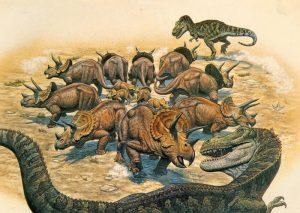
Mourning their loss
Eventually, the stand-off between the P. perotorum herd and the “pack” of N. hoglundi ends when the herd attempts to outrun the theropods. An older male is left behind by the herd and eventually dies trying to fend off his attackers. The herd then looks on solemnly. The scene feels very cinematic and solemn, but it’s not all that realistic to what we see in extant animals. It feels more like a dramatization than a recording of animal behaviour.
Mostly speculation
Goat eyes
Pachyrhinosaurus perotorumis shown with horizontal pupils similar to those seen in goats. While we currently lack any positive evidence for pupil shape in any dinosaur, I would rate this interpretation as plausible. Horizontal pupils are useful for animals that are constantly scanning their horizon, and data on extant animal pupil shape indicates that this is a labile region of anatomy that can be selected for in response to environmental stress (Malmstrom and Kroger 2006; .Gonzalez-Martin-Moro et al. 2014).

